Table of Contents
- Understanding Homeowners Insurance
- Core Components of a Homeowners Insurance Policy
- Tips for Selecting the Right Coverage
- Common Misconceptions Debunked
- Cost-Effective Ways to Secure Coverage
- Enhancing Your Policy: What to Consider
- Keeping Up with Industry Changes

Understanding Homeowners Insurance
Homeowners insurance is not just a policy; it’s a crucial investment that shields you from the financial brunt of unforeseen disasters. It offers a robust safety net for your home and possessions, from devastating fires to theft. Generally speaking, this insurance has three main components: liability protection against accidents on your property, personal property coverage for the items within your home, and dwelling coverage, which safeguards the actual structure of your home. For individuals residing in hurricane-prone regions such as Florida, seeking affordable homeowners insurance Miami, Florida, is vital to achieving comprehensive coverage without a hefty price tag.
One of the striking yet often understated benefits of homeowners insurance is its role in disaster recovery. It covers the cost of rebuilding your home and aids in temporary relocation by covering additional living expenses. This comprehensive support is crucial for families striving to regain normalcy after a catastrophe. Whether you’re a first-time homebuyer or a longtime homeowner, understanding your coverage details ensures you are prepared for the unexpected.
Core Components of a Homeowners Insurance Policy
A comprehensive homeowners insurance policy is composed of several integral components:
- Dwelling Coverage focuses on the home’s physical structure, including walls, roofing, and built-in appliances. It’s essential for protecting your home against damage from natural disasters, fires, and vandalism.
- Personal Property: Personal property coverage covers loss or damage to personal belongings in your house, including apparel, gadgets, and furniture. It ensures that the financial impact of loss or theft is minimal.
- Liability Protection: Offers coverage against potential lawsuits due to injuries on your property. It is not limited to incidents at home but also includes situations such as your dog biting someone at the park.
These core components can be tailored to suit your lifestyle and personal preferences better. Collectively, they offer a multi-layered defense that safeguards your physical house, belongings, and financial stability.
Tips for Selecting the Right Coverage
Assessing Your Home’s Value
Understanding your property’s value is the cornerstone of selecting the proper coverage. It means evaluating the full cost of rebuilding your home using current labor and material rates, which often illuminates discrepancies between the replacement and market value. A meticulous home inventory, including photographs and receipts, can significantly aid in claim processes and help prevent disputes.
Factoring in Natural Disasters
The geographical location of your property significantly affects the type of insurance required. Homeowners in flood-prone or seismic zones should consider purchasing additional riders or endorsements beyond standard coverage. As the Insurance Information Institute suggests, specialty coverage like flood insurance is vital to cover water damage that isn’t typically included in a basic policy. It’s prudent to evaluate the specific risks your region faces to ensure your policy accurately reflects these realities.
Common Misconceptions Debunked
Misunderstandings about homeowners insurance can lead to inadequate coverage or unexpected costs. A prevalent myth is the assumption that all damages, including those from natural disasters like floods or earthquakes, are inherently covered under standard policies. It isn’t true; these events often require additional, specialized insurance. Similarly, many homeowners mistakenly believe insurance covers their home’s market value rather than its replacement cost, leading to potential shortfalls in payouts during claims. Clarity in policy terms is essential to avoid these costly misconceptions.
Cost-Effective Ways to Secure Coverage
Securing homeowners insurance that balances affordability with adequate protection requires strategic approaches. Consider bundling different types of policies, like home and auto insurance, to avail of multi-policy discounts offered by insurers. Regularly reviewing your policy and comparing it with others facilitates adjustments to new needs or changes in property value. Utilize trusted resources like consumer reports to uncover strategies that can contribute to significant savings by highlighting potential discounts and fortification measures like installing security systems
.
Enhancing Your Policy: What to Consider
For homeowners seeking enhanced protections, adding filings like identity theft protection or insurance for home-based businesses could be a wise investment. These modifications are particularly beneficial for those whose circumstances present unique vulnerabilities, such as remote workers or people with valuable collections. Though initially costly, these endorsements can avert significant losses from specific, non-standard threats. When evaluating the need for such enhancements, balance the costs against potential scenarios to determine their added value to your overall policy structure.
Keeping Up with Industry Changes
The landscape of homeowners insurance is constantly changing, with adjustments in coverage standards, premium calculations, and regulatory frameworks. Staying informed and proactive is essential to ensuring continuous protection that accommodates evolving risks and personal circumstances. Sources like insurance industry journals or subscribing to updates from credible online news outlets can provide valuable insights into market trends, helping policyholders adjust their coverage proactively to maintain optimum protection against emerging threats.